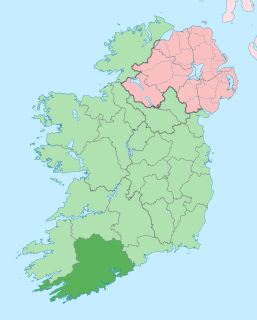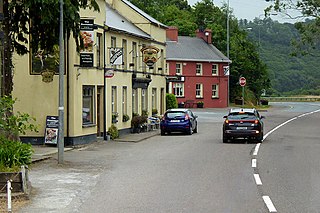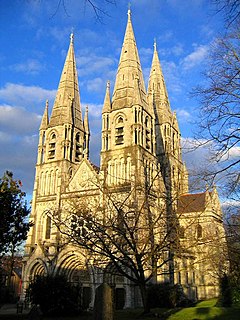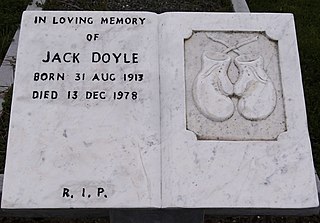
County Cork is the largest and the southernmost county of Ireland, named after the city of Cork, Ireland's second-largest city. It is in the province of Munster and the Southern Region. Its largest market towns are Mallow, Macroom, Midleton, and Skibbereen. As of 2016 the county had a population of 542,868, making it the third-most populous county in Ireland. Cork County Council is the local authority for the county. Notable Corkonians include Michael Collins, Jack Lynch, and Sonia O'Sullivan.

The Red Abbey in Cork, Ireland was a 14th-century Augustinian abbey which took its name from the reddish sandstone used in construction. Today all that remains of the structure is the central bell tower of the abbey church, which is one of the last remaining visible structures dating to the medieval walled town of Cork.

The Kingdom of Desmond was a historic kingdom in southwestern Ireland. It was founded in 1118 by Tadhg Mac Cárthaigh, King of Munster when the Treaty of Glanmire formally divided the Kingdom of Munster into Desmond and Thomond. It comprised all of what is now County Cork and most of County Kerry. Desmond was ruled by the Mac Cárthaigh (MacCarthy) dynasty. Other clans within the kingdom included the O'Sullivans and O'Donovans. Following the Norman invasion of Ireland in the late 12th century, the eastern half of Desmond was conquered by the Anglo-Normans and became the Earldom of Desmond, ruled by the Fitzmaurices and FitzGeralds—the famous Irish family known as the Geraldines. The king of Desmond, Diarmaid Mac Cárthaigh submitted to Henry II of England, but the western half of Desmond lived on as a semi-independent Gaelic kingdom. It was often at war with the Anglo-Normans. Fínghin Mac Carthaigh's victory over the Anglo-Normans at the Battle of Callann (1261) helped preserve Desmond's independence. The kings of Desmond founded sites such as Blarney Castle, Ballycarbery Castle, Muckross Abbey and Kilcrea Friary. Following the Nine Years' War of the 1590s, Desmond became part of the Kingdom of Ireland.

Kinsale is a historic port and fishing town in County Cork, Ireland. Located approximately 25 km (16 mi) south of Cork City on the southeast coast near the Old Head of Kinsale, it sits at the mouth of the River Bandon, and has a population of 5,281 which increases in the summer when tourism peaks.

West Cork is a tourist region and municipal district in County Cork, Ireland. As a municipal district, West Cork falls within the administrative area of Cork County Council, and includes the towns of Bantry, Castletownbere, Clonakilty, Dunmanway, Schull and Skibbereen, and the villages of Baltimore, Ballydehob, Courtmacsherry, Drimoleague, Durrus, Glengarriff, Leap, Rosscarbery, Timoleague and Union Hall.

Castlemartyr is a village in County Cork, Ireland. It is located 25 minutes east of Cork city, 10 km (6 mi) east of Midleton, 16 km (10 mi) west of Youghal and 6 km (4 mi) from the coast. Approximately 1,600 people live in the village and its hinterland. It is situated on the N25 national primary road.

Knowth is a Neolithic passage grave and an ancient monument of the World Heritage Site of Brú na Bóinne located 8.4 km west of Drogheda in Ireland's valley of the River Boyne. It is the largest passage grave of the Brú na Bóinne complex. It consists of a large mound and 17 smaller satellite tombs. The mound is about 12 metres (40 ft) high and 67 metres (220 ft) in diameter, covering roughly a hectare. It contains two passages placed along an east-west line and is encircled by 127 kerbstones, of which three are missing, and four badly damaged.

Douglas is a suburb, with a village core, in Cork city, Ireland. Douglas is also the name of the townland, Roman Catholic parish, Church of Ireland parish and civil parish in which it is contained.

James Fort is an early 17th-century pentagonal bastion fort located on Castlepark peninsula in Kinsale harbour, County Cork, Ireland. Situated downstream from Kinsale on the River Bandon, the fort was built to defend the harbour and seaborne approaches of the town. Following the construction of Charles Fort on the opposite side of the harbour in the late 17th century, James Fort became known as the "old fort". Listed as a protected National Monument, and managed by the Office of Public Works, the fort is open to visitors.

The Castlepark peninsula in Kinsale harbour on the coast of County Cork, on the south coast of Ireland is really more a presque-isle than a peninsula, being joined to the mainland only by an extremely narrow neck at its north-western corner. Thus, the Castlepark peninsula is almost surrounded by water: the River Bandon, flowing from the north-west, bounds the peninsula on the north; the entrance to Kinsale harbour bounds the peninsula on the east; the Atlantic Ocean bounds it to the south; and the tidal inlet known as Sandycove Creek bounds the peninsula on the west. Most traffic into Castlepark now arrives via the Duggan Bridge, built 1976, which crosses the River Bandon from the northern, Kinsale, bank just east of the neck which joins the peninsula to the mainland.

Charles Fort is a trace italien fortification, a bastion fort with one section of the outer wall built in star fashion. It is located on the water's edge, at the southern end of the village of Summer Cove, on Kinsale harbour, County Cork, Ireland. First completed in 1682, Charles Fort was sometimes historically referred to as the "new fort" - to contrast with James' Fort which had been built on the other side of Kinsale harbour before 1607. The fort is now operated as a heritage tourism site by the Heritage Ireland arm of the Office of Public Works.

Belgooly is a village in County Cork, Ireland, located 4.6 kilometres to the north-east of Kinsale. In 2016 it had a population of 826.

St. Finbarr's Cemetery in Cork, Ireland, is the city's largest and one of the oldest cemeteries in Ireland which is still in use. Located on the Glasheen Road, it was first opened in the 1860s. The entrance gateway was erected circa 1865, and the mortuary chapel consecrated in 1867.

Barryscourt Castle is a castle located in eastern County Cork in southern Ireland, close to the town of Carrigtwohill.

Dunasead Castle, sometimes known as Baltimore Castle, is a 17th-century fortified house situated in the town of Baltimore in western County Cork, Ireland. The tower house is built on the site of an earlier Norman-era structure, which itself replaced an earlier Bronze Age ringfort. Traditionally associated with the O'Driscoll family, it was purchased and restored by members of the McCarthy family in the late 1990s, and partially opened to the public from 2005.

The Diocese of Cork, Cloyne and Ross, also referred to as the United Diocese of Cork, Cloyne and Ross, is a diocese in the Church of Ireland. The diocese is in the ecclesiastical province of Dublin. It is the see of the Bishop of Cork, Cloyne and Ross, the result of a combination of the bishoprics of Cork and Cloyne and Ross in 1583, the separation of Cork and Ross and Cloyne in 1660, and the re-combination of Cork and Ross and Cloyne in 1835.

The Old Church Cemetery is an ancient cemetery on the outskirts of the town of Cobh, County Cork, Ireland which contains a significant number of important burials, including a number 3 mass graves and several individual graves containing the remains of 193 victims of the passenger ship RMS Lusitania which was sunk by a German torpedo off the Old Head of Kinsale during the First World War in May 1915 with the loss of more than 1,100 lives. The Commonwealth War Graves Commission register and maintain the graves of 127 identified Commonwealth service personnel from the same war.

South Parish is the name given to both a Roman Catholic parish of Cork City and to the residential area contained in it.

The Church of St Peter is the 13th-century Anglican parish church for the village of Shirwell in North Devon. It is a Grade I listed building and comes under the Diocese of Exeter. The family church of the Chichester Family who lived locally, the aviator and sailor Sir Francis Chichester, who was born in Shirwell, is buried in the churchyard.

Shandon Castle, originally known as Lord Barry's Castle, was an early medieval castle in the Shandon area of Cork city in Ireland. It was built in the late 12th century by Philip de Barry, close to an earlier ringfort. Located outside the city's gates and defensive walls, the castle was a seat of the Cambro-Norman de Barry family for several centuries.




















